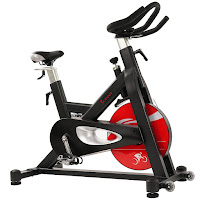 |
| Ad >>Click here to view or buy from a wide range of exercise bikes<< |
The two most common types of resistance typically found on exercise bikes are magnetic or friction resistance. I will explain how each type of resistance works below to help you understand the difference between magnetic and friction and how each affects the workings of an exercise bike.
Exercise bikes utilize a flywheel system, consisting of a heavy metal disk that is connected to the bike’s pedals. As you cycle, the pedals turn the flywheel and the rotational energy is stored in the flywheel. Either magnetic or friction resistance is then used to effectively add a braking effect to the flywheel. By changing the resistance level, you can effectively increase or decrease the intensity of your cycling workout.
MAGNETIC Resistance on an Exercise Bike Explained:
Exercise bikes that utilize magnetic resistance have powerful magnets each side of the flywheel that create a magnetic field. As you pedal, the flywheel rotates and interferes with the magnetic field created by the magnets, thus creating an opposing force, i.e. resistance.
With magnetic resistance, as you turn up (increase) the tension level, the magnets will move closer to the flywheel to create a braking effect that makes it harder to pedal. As you turn down (decrease) the tension level, the magnets will move further away from the flywheel, making pedaling easier.
Because no parts ever touch the flywheel with magnetic resistance on an exercise bike, advantages include:
· No friction
· No noise, i.e. silent or near-silent operation
· Quicker & smoother resistance level changes
· A wider range of resistance levels with more precise tension control
· Smoother pedaling action
· No wearing parts
· No or little maintenance
FRICTION Resistance on an Exercise Bike Explained:
Exercise bikes that utilize friction resistance have brake pads that come into direct contact with the flywheel, working in a similar way to a road bike or car brake – as you increase the resistance level, the more contact the brake pad will have with the flywheel and the harder it will be to pedal.
Friction resistance therefore has one part rubbing against another part in order to create the friction - with exercise bikes this is the brake pad (typically a felt pad) rubbing against the bike’s flywheel to create the friction resistance.
Some people prefer the friction resistance on an exercise bike (especially on a spin bike) as they say it more truly replicates the feel of a real road bike.
Disadvantages of Friction Resistance on an Exercise Bike:
Because of the way friction resistance works, i.e. parts rubbing against each other, it does have several disadvantages when compared with magnetic resistance on exercise bikes, including:
· Parts may wear out over time as they rub against each other
· Maintenance typically required
· Noisy in operation due to parts rubbing against each other
· Pedaling action may not be as smooth
· A smaller range of resistance levels
· Resistance changes may not be as smooth or as precise
N.B. It’s always advisable to consult your doctor or healthcare professional before undertaking any new exercise regime.
*Prices/discounts/shipping indicated correct at time of writing/publishing and may be subject to change anytime. E&OE.
Related articles:
No comments:
Post a Comment